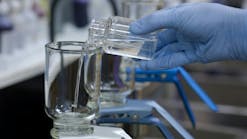New method regenerates zinc-nickel electrolytes
A new recycling method developed by Goema of the Christ Water Technology Group enables process baths containing zinc-nickel alloys to be regenerated without chemicals, thus making the regular preparation of new baths unnecessary.
Rinsing water containing the zinc-nickel alloy is passed through a specially designed vacuum evaporator. Organic waste substances, dirt particles and valuable substances are separated from each other and can be disposed separately or re-used. The distilled water and zinc-nickel electrolyte are returned to the bath, resulting in a fully closed circuit.
About 90% of the valuable substances are recycled, and no additional chemicals are needed. The system needs no additional rinsing water and generates no wastewater. The compact, stainless steel system is available in various versions with outputs of 50 to 5,000 l/hr. The continuous regeneration of the zinc-nickel electrolyte ensures uniform precipitation of the zinc-nickel alloy and a constantly good bath and coating quality. The vacuum evaporator operates independently with its own heat pump or conventionally from the mains supply with a power consumption of about 18 kWhr/m3. The German Federal Ministry for Education and Research sponsored the development of this method.
Goema AG
Vaihingen, Germany
RO membrane lowers energy costs
The FilmTec™ SW30XLE-400i element, a reverse osmosis membrane, requires the lowest energy in the industry to deliver the lowest total cost of water in seawater desalination applications, claims FilmTec, a subsidiary of The Dow Chemical Company.





